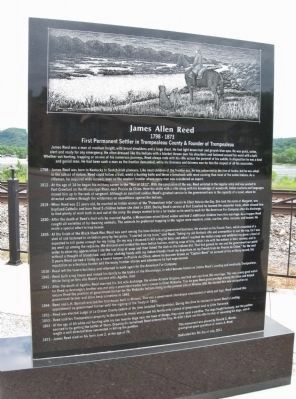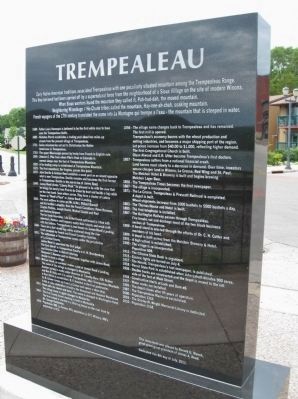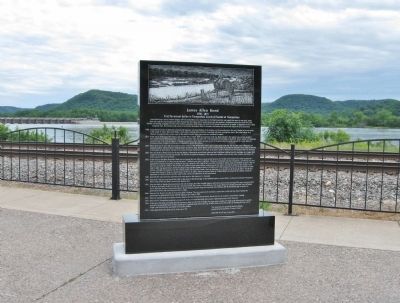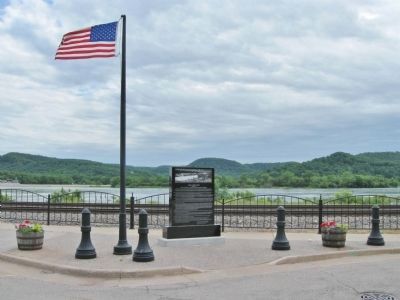Trempealeau in Trempealeau County, Wisconsin — The American Midwest (Great Lakes)
James Allen Reed / Trempealeau
1798 - 1873
First Permanent Settler in Trempealeau County & Founder of Trempealeau
James Reed was a man of medium height, with broad shoulders and a large chest. He had light brown hair and grayish blue eyes. He was quick, active, alert and ready for any emergency. He often dressed like the Indians with a blanket thrown over his shoulders and fastened around his waist with a belt. Whether out hunting, trapping or on one of his numerous journeys, Reed always rode with his rifle across the pommel of his saddle. In disposition he was a kind and genial man. He had been such a man as the frontier demanded, while his firmness and fairness won for him the respect of all his associates.
1798 - James Reed was born in Kentucky to Scotch-Irish pioneers. Like most children of the frontier era he was unlearned in the lore of books, but he was adept in the school of nature. Reed could follow a trail, wield a hunting knife and throw a tomahawk with more cunning than most of the native Indians. As a rifleman, he acquired wide renown, even on the western frontier where every man was considered an expert.
1812 - At the age of 14 he began his military career in the “War of 1812”. With the conclusion of the war, Reed enlisted in the regular army and was posted to Fort Crawford on the Mississippi River, near Prairie du Chien. Here his skills with a rifle along with his knowledge of woodcraft, Indian customs and languages moved him up to the rank of sergeant. Although an excellent soldier, Reedís greatest service to the government was in the capacity of a scout, where he directed soldiers through the wilderness on expeditions against the Indians.
1819 - When Reed was 21 years old, he married an Indian woman of the “Potawotomi tribe” cousin to Chief Hole-in-the-Day. She took the name of Margaret, was baptized Catholic and bore Reed 5 children before she died in 1830. During Reedís service at Fort Crawford he learned the carpenter trade, which allowed him to find plenty of work both in and out of the army. He always wanted to be a fur trader so he went to work for the American Fur Company after his discharge.
1830 - After the death of Reedís first wife he married Agatha, a Menominee mixed blood widow and had 2 additional children from this marriage. As a trapper Reed caught all varieties of fur-bearing animals. The animals he preferred trapping in the region were muskrat, mink, marten, otter, raccoon, and beaver. He made a special effort to trap beaver.
1835 - At the finish of the Black Hawk War, Reed was sent among the Iowa Indians on government business. He started on his French Train, which consisted of a sled of oak fastened to an Indian pony by two poles. “I started on my train,” said Reed, “taking my old flintlock rifle and ammunition to last the trip, for I was expected to kill game enough for my living. On my way I chanced to kill a big, fat bear, and when I reached the Indian camp and exhibited my game a howl of joy went up among the redskins. We dressed and cooked the bear Indian fashion, making soup of him, which I ate with the natives in their manner, and in order to show my appreciation I ate the last drop of soup and then licked the dish as the Indians did. That lick gained for me and the government our point without a thought of blood shed, and after shaking hands with my Indian friends I took my departure on my French train for Prairie du Chien.” For the next 3 years Reed earned a living as a tavern keeper in Prairie du Chien, where he became known as “Captain Reed” on account of his military record, his reputation as a fearless hunter and the many frontier stories and adventures he had experienced.
1838 - Reed left the tavern business and returned to work again for the American Fur Company.
1840 - Reed built a log house and moved his family to the banks of the Mississippi, in what became known as James Reedís Landing and eventually Trempealeau. While living on this site Reedís second wife, Agatha, died.
1841 - After the death of Agatha, Reed married his 3rd wife Archange, the widow Amable Grignon, and had one son from this marriage. This was a very good match for Reed as Archangeís brother was not only a prominent trader, but a cousin to Chief Wabashaw. This tie gave Reed great prestige among the Sioux helped secure Reed the position of government farmer for the Wabashaw Indians living on the present site of Winona, MN. He started this new occupation as government farmer and store keep some time in 1842.
1844 - Reed and L.H. Bunnell erected the first house built in Winona. This was a government storehouse constructed of white ash logs. Reed retained this appointment as government farmer until the signing of the Treaty in 1851.
1851 - Reed was elected Justice of La Crosse County (which at the time included Trempealeau). During this time he resided in James Reedís Landing.
1853 - Reed sold his Trempealeau property to Benjamin B. Healy and moved his family onto a piece of government land in Little Tamarack.
1863 - At the age of 65 while out hunting with his two favorite dogs near the town of Dodge, they came upon a panther. The dogs fought furiously, but the panther seemed to be getting the better of them. Drawing his tomahawk Reed entered the fray, he didnít dare use his rifle for fear of wounding his dogs, and at length a well directed blow
succeeded in killing the panther.
1873 - James Reed died on his farm June 2, at the age of 75.
great-great-great-grandson of James A. Reed.
Dedicated this 8th day of July, 2011.
Early Native American traditions associated Trempealeau with one peculiarly situated mountain among the Trempealeau Range. This they believed had been carried off by a supernatural force from the neighborhood of a Sioux Village on the site of modern Winona. When Sioux warriors found the mountain they called it, Pah-had-dah, the moved mountain. Neighboring Winnebago / Ho-Chunk tribes called the mountain, Hay-nee-ah-chah, soaking mountain. French voyagers of the 17th century translated the name into La Montagne qui trempe a l'eau - the mountain that is steeped in water.
1680 - Father Louis Hennepin is believed to be the first white man to have seen the Trempealeau bluffs.
1685 - Nicholas Perrot establishes a trading post about two miles up stream from the present village of Trempealeau.
1731 - Swiss missionaries set out to Christianize the Native Americans in Trempealeau.
1763 - The upper Mississippi passes by treaty from French to English rule.
1805 - Zebulon E. Pike from whom Pike's Peak in Colorado is named sleeps near the foot of Trempealeau Mountain.
1820 - A fur trading camp is established at Trempealeau Mountain.
1823 - The first steamboat, the Virginia, passes this point.
1837 - John Doville & Antoine Reed established a wood yard on an island opposite what is now Trempealeau. Doville is the son-in-law of James Reed.
1840 - James Reed climbs "Liberty Peak." So pleased is he with the view that he brings his family from Prairie du Chien by boat and builds a log cabin on the river bank. Soon others arrive. They form a cluster of cabins known as "Reed's Place" or James Reed's Landing.
1843 - The next settlers to come are Mr. & Mrs. Willard Bunnell and his brother Lafayette; then the French Canadians: Peter Rosseau, Charles Perkins, Joseph Boulte, Michael Goulet and Paul and Antoine Grignon.
The fur trade flourishes. Life in the French settlement is filled with adventure. Hunters and trapers match their talents and wood craft with the Indians. Trempealeau is now known as James Reed's Landing.
1846 - There are a half dozen log cabins scattered along the river front occupied by French and French Canadian families.
1851 - The settlement of Trempealeau comes under the jurisdiction of La Crosse County.
James Reed is appointed the first judge.
The first sheriff in Trempealeau County is A. M. Brandenburg and Charles Utter is district attorney.
Benjamin F. Hueston and Ira Hammond, together with James Reed, decide to form a village.
1852 - William Hood, as surveyor, makes a plat of James Reed's landing.
The name of the village is changed to Montoville.
Another survey is made under direction of Timothy Burs, F.M. Rublee and Ben B. Hely and it is called Trempealeau, after Trempealeau Mountain.
A Post Office is established, B. F. Hueston is the first postmaster.
N. B. Grover comes up from La Crosse and opens a shoe shop.
A 4th of July celebration is held in the Hammond and Hueston Warehouse.
1853 - Reed sells his tavern and hotel. The name is changed to Washington Hotel.
The village name is again changed to Montoville.
1854 - The first County board meeting is held in Montoville.
The first school is started in a little log house on the river front by Mr. George Batchelder.
1855 - Population 388. La Crosse, WI's population is 577. Winona, MN's population is 813.
1856 - The village name changes back to Trempealeau and has remained.
The first mill is opened.
Trempealeau's economy booms with the wheat production and milling industries, and becomes a major shipping port of the region.
Lot prices increase from $40.00 to $1,000, reflecting higher demand.
The first Congregational Church is built.
Olson Atwood and E.R. Utter become Trempealeau's first doctors.
1857 - Trempealeau suffers from a national financial crash.
Land barons react slowly to a decrease in demand. Over time, investors secure cheaper land in Winona, La Crosse, Red Wing and St. Paul. The Melchoir Hotel & Brewery is built and begins brewing Melchoir Lager Beer.
1858 - The Trempealeau Times becomes the first newspaper.
1867- The village is incorporated.
1871 - The La Crosse, Trempealeau & Prescott Railroad is completed.
A depot is built.
Wheat shipments increase from 1000 bushels to 5000 bushels a day.
1883 - The Thomas House and Hotel is built.
1885 - The first telephone is installed.
1887 - The Burlington Railway passes through Trempealeau. Fire breaks out and destroys most of the two block business section of Trempealeau.
1888 - A band stand is erected through the efforts of Dr. C. H. Cutter and members of his band.
1889 - A depot is built across from the Melchoir Brewery & Hotel.
1891 - A high school is established.
1900 - The village is re-incorporated.
Population 609.
1912 - The Citizens State Bank is organized.
1915 - Electric lights are turned on July 4.
1917 - The Herald, Trempealeau's last newspaper, is published.
1918 - Perrot State park is established when John Latsch donates 900 acres.
1926 - Double tracks are constructed and the depot is moved to the left side of the foot of Main Street.
1934 - Construction starts at Lock and Dam #6.
1937 - Water works are installed.
1965 - The depot closes after 95 years of operation.
1987 - The Trempealeau Marina is established.
2000 - Population 1310.
2003 - The Shirley M. Wright Memorial Library is dedicated.
2010 - Population 1518.
great-great-great-grandson of James A. Reed.
Dedicated this 8th day of July, 2011.
Erected 2011 by Ronald G. Wanek.
Topics. This historical marker is listed in this topic list: Settlements & Settlers. A significant historical month for this entry is June 1929.
Location. 44° 0.241′ N, 91° 26.562′ W. Marker is in Trempealeau, Wisconsin, in Trempealeau County. Marker is at the intersection of 1st Street and Main Street, on the right when traveling east on 1st Street. Touch for map. Marker is in this post office area: Trempealeau WI 54661, United States of America. Touch for directions.
Other nearby markers. At least 8 other markers are within 6 miles of this marker, measured as the crow flies. The Mississippi River Parkway: (approx. 0.9 miles away); French Post (approx. 1.7 miles away); Brady's Bluff (approx. 1.9 miles away); Great River Bluffs (approx. 2.1 miles away in Minnesota); The Geology of Perrot State Park (approx. 2.6 miles away); Historic Lake Labelle (approx. 3.1 miles away in Minnesota); Pickwick Mill (approx. 3.1 miles away in Minnesota); The Bunnell House (approx. 6 miles away in Minnesota). Touch for a list and map of all markers in Trempealeau.
Also see . . . James Allen Reed: First Permanent Settler in Trempealeau County and Founder of Trempealeau. 1915 book. (Submitted on February 23, 2014.)
Credits. This page was last revised on June 16, 2016. It was originally submitted on February 23, 2014, by Keith L of Wisconsin Rapids, Wisconsin. This page has been viewed 1,240 times since then and 79 times this year. Photos: 1, 2, 3, 4. submitted on February 23, 2014, by Keith L of Wisconsin Rapids, Wisconsin.



